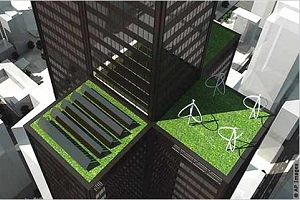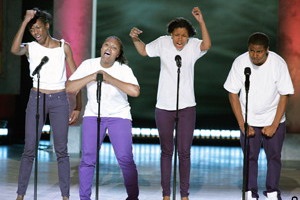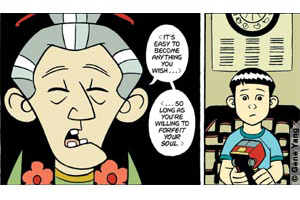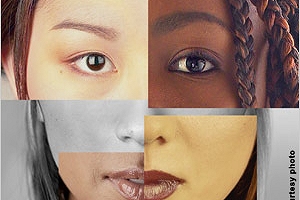Focus on America
The Greening of U.S. Architecture: Students promoting eco-design

With many residential and corporate clients now requesting an environmentally friendly approach to their design needs, so-called “green architecture” has become an increasingly hot commodity, and a number of U.S. universities have responded by developing sustainable-design courses for their architecture programs. Most often, students themselves are driving that trend, say two prominent educators.
Architecture professors Linda Keane (of the Art Institute of Chicago) and Walter Grondzik (of Ball State University in Muncie, Indiana) recently told America.gov how architecture is evolving to meet new energy requirements — and how young architects-in-training are learning new skills to meet the challenges of the 21st century.
Although public awareness of “green” architecture is a relatively recent phenomenon, Keane said that its foundations can be traced to the 1970s, when a small vanguard of progressive architects began creating “passive solar” buildings that drew upon renewable energy sources.
“There were firms practicing this way, but they were on the fringe,” Keane recalled, “and it wasn’t called ‘green architecture’ then.” She cited the “age-old principles of natural ventilation and use of sunlight,” which were already being incorporated into certain design schemes — and which have been rediscovered and embraced by today’s environmentally conscious practitioners.
A few schools “were teaching sustainable principles 30–40 years ago, ahead of the curve,” Grondzik said. These days, more schools are offering courses on energy-efficient design and the use of sustainable materials, but Keane and Grondzik both cautioned that the “greening” of U.S. architecture programs is in its infancy. Grondzik estimated that “maybe 10 percent of U.S. architecture schools do a fairly good job” of grounding students in the precepts of sustainability.
“It’s a slow process,” he said. “And it’s definitely not mandatory” for students to address environmental concerns in most architecture programs. But in years to come, he predicted, the sustainable-design movement “will be gaining momentum” as a new, “greener” crop of architects enters the work force.
“It’s all about generational change,” he said. “I think the stronger architecture programs have been student-initiated. Schools have responded to student demand” for more instruction on sustainability.
Keane agreed. “It takes time to change behavior; people are often resistant to change,” she said. “But a lot of younger people are attuned to the concept of sustainable design, and this will probably turn the tide in the years ahead.”
Even at architecture schools that excel in teaching sustainability, requirements for graduation may vary — but most programs expect students to undertake internships so that they acquire some hands-on design experience, whether eco-related or not. “A broad internship is a linchpin of our program” at Ball State University, Grondzik said.
At the Art Institute of Chicago, “we have a series of courses known collectively as The Green Zone,” Keane said. “These are a cluster of courses that focus on energy-efficient design, and students who are interested can take them all.” Moreover, “some schools offer LEED [Leadership in Energy and Environmental Design] courses,” she said, referring to a rating system that recognizes outstanding sustainable design. “Many of our students are LEED-certified as they graduate. We also have a historic preservation program” that emphasizes the retrofitting of existing structures to reduce their carbon footprint.
Retrofitting is an important aspect of sustainable architecture; no less a landmark than New York’s iconic Empire State Building has recently undergone a multi-step conversion process to become more energy-efficient. While academic programs tend to focus on designing new buildings that are sustainable from the start, “a lot of practitioners are aware of retrofitting as a potential growth industry,” Grondzik said.
According to Keane, bringing sustainable design to urban areas can restore a sense of connection to the natural world. “The most visual change has been the green roofs” that often feature grass, trees and plants, she said. “It’s an amazing thing to be on a green roof in the middle of surrounding skyscrapers. Everything else in the city is paved in hard surfaces. It’s a return to trying to live more gracefully.”
Grondzik observed that there is much confusion about terms such as “green” and “sustainable,” which are closely related but not synonymous. “Sustainability is really our ability to live within our environmental means,” he said. “A sustainable project cannot pollute, and cannot rely on nonrenewable resources. Green is a step towards sustainable, but it’s not completely carbon-neutral.”
Whether merely “green” or fully sustainable, architecture is adapting to meet the needs of the modern world. “I read an article that says more than 50 percent of clients initiate the demand for sustainable design,” Grondzik said. “In many cases, they’re actually pulling the architects along.”
Added Keane: “It’s an exciting time. When I came to the Art Institute of Chicago in 1985, no one was interested in sustainable design. Now, artists, architects, designers and scientists — everyone’s interested. It feels like we’re on the cusp of change.”
By Lauren Monsen
Staff Writer
Recently on Focus on America
Poetry Slams Build Confidence, Promote Free Speech
 Slam poetry, part of a tradition of spoken performance in the United States, is driven by poets of diverse backgrounds who see it as a tool of free expression.
Slam poetry, part of a tradition of spoken performance in the United States, is driven by poets of diverse backgrounds who see it as a tool of free expression.
Graphic novels - Drawing the Asian-American Experience
 Asian-American artists and writers have attained considerable prominence as creators of sophisticated graphic novels, many of which explore cultural identity and social issues.
Asian-American artists and writers have attained considerable prominence as creators of sophisticated graphic novels, many of which explore cultural identity and social issues.
Americans May Be Thinking About Identity in New Ways
 Most scholars, writers, politicians and others agree that with the possible exception of the American Indian, to be American is to be, genealogically speaking, from somewhere else in the world. America.gov explores how choosing individual identity is an ever-shifting process.
Most scholars, writers, politicians and others agree that with the possible exception of the American Indian, to be American is to be, genealogically speaking, from somewhere else in the world. America.gov explores how choosing individual identity is an ever-shifting process.